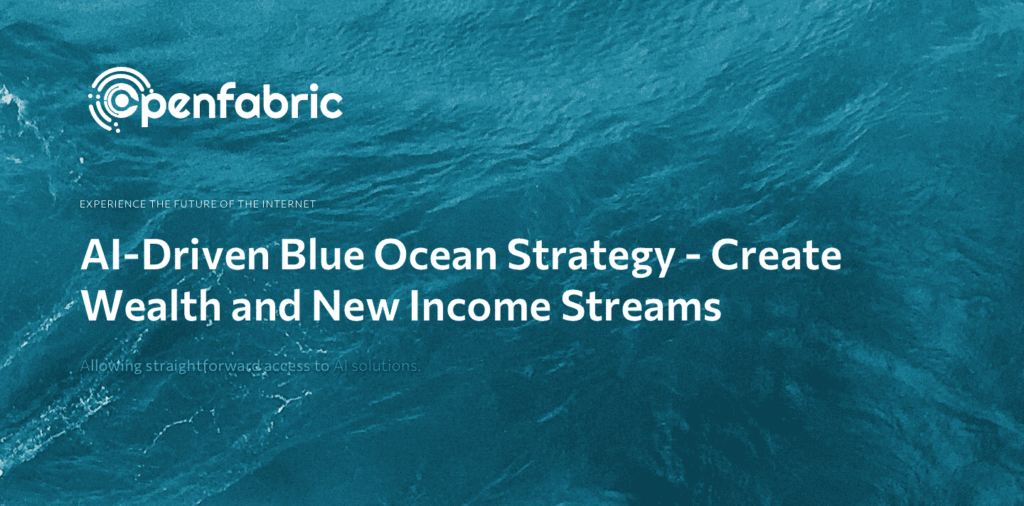
August 16, 2021 5 minutes read
AI Blue Ocean Strategy – Wealth and New Income Streams

AI-driven change is coming sooner than most of us probably expect. Today, software can already “learn” and do more and more of what people do. The possibilities are almost limitless from providing customer service and information to analyzing X-rays, reading test reports, performing system audits, and giving legal advice. As technology improves, more and more economic activity will shift from labor to capital.
This technological revolution has probably passed the point of no return. With the right AI tools, the smart machines of today can help us make even smarter machines tomorrow.
What can we expect from this Blue Ocean AI revolution?
Here are a few ideas:
- This technological revolution will create a great deal of wealth as labor costs fall and low-cost AI solutions become commonplace.
- Policy changes will help people create, access, and use this wealth. Thus allowing them to spend more time on higher value-added life pursuits. The policy changes include specifying the access and usage guidelines for AI, including its availability and the applications permissible.
- If we figure out a Blue Ocean AI strategy correctly, provide people with the adequate tools and services for creating tech-driven value, we can significantly improve the standard of living of people all around the world
In the sections below, we will provide an overview of how and why we think the points above are inevitable. We will also see how AI will drive the creation of new Blue Oceans — new markets created by differentiation and low-cost production — and how Openfabric is helping to drive these changes.
The AI Revolution
Tech developments and advancements occur at an exponential rate. Hardly 15 years ago, there were no smartphones. About 150 years ago, there was no home electricity. Go back 1,500 years and there were no large-scale machines, and go back 15,000 years and there was no planned/organized agriculture.
The next big driver of global change will revolve around the ability to help machines think, create and understand. Once it gains steam, the technological progress over the next few decades will dwarf all of our most impressive inventions from the last 5,000 years.
Moore’s Law
We can all be better off if we have more wealth or prices fall. The best way to increase social wealth is to lower the cost of everything. As we discussed above, technology has the potential to do that.
Moore’s Law is a prime example of this in action. For the last decades, as microchips and processors became more powerful and shrank in size but prices remained constant in two-year phases.
We’ve seen prices fall dramatically for consumer goods of many types. We’ve seen this in TVs and computers to other durables. However, the costs of housing, healthcare services, and higher education have risen dramatically. We cannot collectively enjoy more wealth unless we manage all types of costs.
The involvement of AI
AI has the power to lower the costs of goods and services. This is especially where labor is the primary cost driver in the supply chain. If a robot can construct a house using the lowest-cost materials available and use solar power in the process, home costs will fall. Similarly, if AI-powered “doctors” can diagnose and treat health issues as well as or even better than human doctors, the price of healthcare should fall as well.
If we can build Moore’s Law into everything, technology can help us create a world in which everything from housing and education to food and clothing becomes better or at least half as expensive every two years.
Wealth for Everyone
Inclusivity is required for stable and sustained economic growth. This means giving everyone a fair shot at accessing the resources needed to create value for themselves. Modern societies use taxes to reduce the inequalities created by the unequal distribution of the wealth created by society. However, as we can see by just looking at the world around us, taxes don’t always work.
The ever-widening wealth gap is a major cause for concern for the stability of the current economic and political system. What we need is to improve access to the resources that can create wealth. These resources, we argue, will increasingly take the form of access to AI capabilities in the years to come. This means the companies that make or use AI will be large drivers of wealth creation in the future, and it will be in everyone’s interests to see these companies do well.
We can explain how this is the case with an example.
Land-value taxes were introduced in some areas in the 1800s. As the value of a parcel of land appreciates because of the wealth-generating activity that takes place on it, more taxes that can be redirected back to the land. For example, to improve and maintain the public transportation that makes it accessible or provide services to the businesses that operate on it. Even if the owner of the land didn’t directly contribute to that value creation, it is only fair for that value to be distributed to everyone.
We collectively have a stake in how well we do, and we all want to do better. As such, we want to empower as many companies and individuals to develop AI solutions. This should not be reserved for a few large entities or corporations. It impacts us all, and access to AI and the ensuing benefits of using AI should be as easy, democratic, and hassle-free as possible.
Creating a New System
As mentioned at the beginning of this post, technology is and will continue to create more and more wealth. We need better distribution and access to the drivers of this wealth creation.
Openfabric is on a mission to do both things. How do they plan to do this?
- By helping AI developers reach customers and monetize their work
- By making it easier for both technical and non-tech users to tap into the vast potential and power of AI.
Openfabric is leveling the playing field, removing access barriers and changing norms. It aim to popularize the quick, easy, and low-cost integration of AI capabilities that will drive the next wave of wealth creation and technological advancement.
To learn more about the implications of these changes and how the Openfabric platform is helping the revolution, visit us today at whitepaper | twitter.

